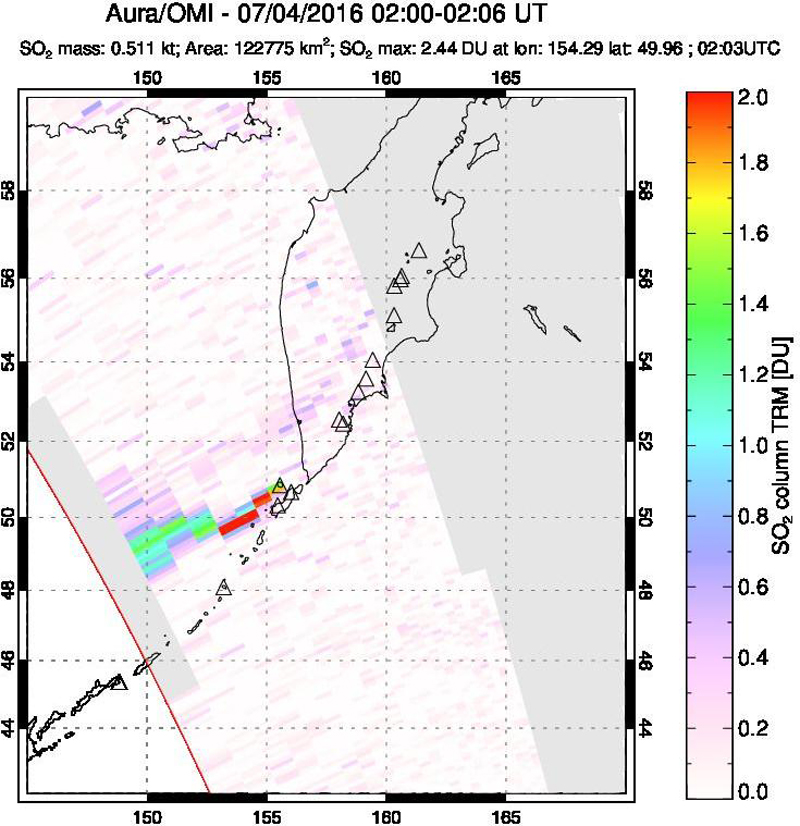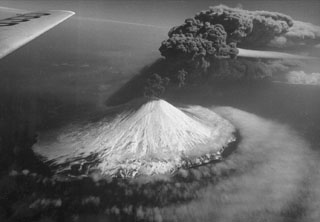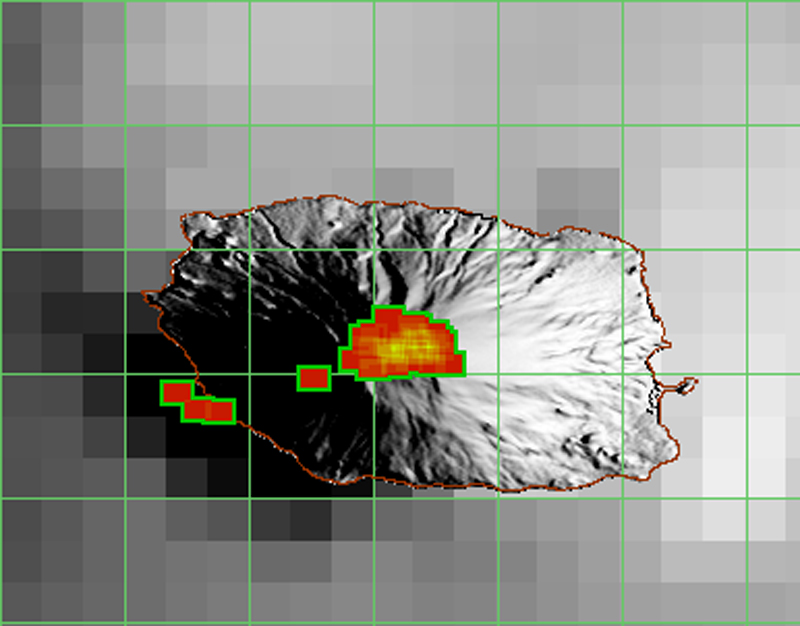Report on Alaid (Russia) — April 2017
Bulletin of the Global Volcanism Network, vol. 42, no. 4 (April 2017)
Managing Editor: Edward Venzke.
Edited by A. Elizabeth Crafford.
Alaid (Russia) Ash plumes and lava flow, October 2015 to August 2016
Please cite this report as:
Global Volcanism Program, 2017. Report on Alaid (Russia) (Crafford, A.E., and Venzke, E., eds.). Bulletin of the Global Volcanism Network, 42:4. Smithsonian Institution. https://doi.org/10.5479/si.GVP.BGVN201704-290390
Alaid
Russia
50.861°N, 155.565°E; summit elev. 2285 m
All times are local (unless otherwise noted)
Russia's Alaid volcano, located just off the southern tip of the Kamchatka Peninsula, is the northernmost of the chain of volcanoes that comprise the Kuril archipelago. A number of strong explosive eruptions have been recorded there in the last 200 years, including VEI 4 explosions in 1790 and 1981. The last eruption occurred between 5 October and 12 December 2012 when repeated thermal anomalies and ash plumes from the summit crater were observed. A new eruption was first reported on 29 September 2015 by the Tokyo Volcanic Ash Advisory Center (VAAC) (BGVN 41:06). Alaid is monitored by the Kamchatka Volcanic Eruptions Response Team (KVERT); valuable information about this remote site is also gathered from satellite thermal infrared data reported by both the University of Hawai'i's MODVOLC system and the Italian MIROVA system.
A new eruption at Alaid was reported on 29 September 2015. It was characterized by strong thermal anomalies and intermittent gas-and-ash plumes. The thermal anomalies were interpreted by KVERT as Strombolian eruptions and lava flows. The first episode of the eruption exhibited strong thermal anomalies with only two reports of ash, and lasted until 4 January 2016. The second episode began with the reappearance of a strong thermal anomaly and an ash plume on 20 February 2016. This was followed by a series of low-level ash plumes in March and April, and ongoing strong thermal anomalies through early May. The anomalies decreased during mid-May and June, but then a large spike of intense anomalies in the first week of July was accompanied by ash plumes and observations by KVERT of Strombolian eruptions at the summit crater and a lava flow down the SW flank. Thermal activity decreased substantially following this spike, and tapered off completely by the second week of August 2016.
The Tokyo VAAC reported an eruption at Alaid at 2120 UTC on 28 September (0720 on 29 September local time) 2015. They reported it as below 6.1 km altitude, and volcanic ash was not identifiable in satellite images. KVERT raised the Aviation Color Code from Green to Yellow early on 2 October 2015 (local time) based on an intense thermal anomaly observed during the night that they interpreted to be the beginning of a new Strombolian eruption. The first thermal anomalies identified by MIROVA (Middle InfraRed Observation of Volcanic Activity) also appear during the first two days of October (figure 5). MODVOLC thermal alerts first appeared on 5 October and were essentially continuous with no more than a few days break until 4 January 2016. The MIROVA signal remained steady until about the same date when it abruptly decreased. KVERT reported consistent and usually intense thermal anomalies, when the volcano was not obscured by clouds, until 4 January. They observed anomalies in satellite images with decreasing frequency and intensity during the rest of January and into early February.
The first report of observed gas-and-steam activity (after the Tokyo VAAC report on 29 September) was by KVERT on 16 December. Visual observations from nearby Paramushir Island (45 km SE) noted a small amount of ash in the steam-and-gas plumes on 28 and 29 December. The Tokyo VAAC also reported a plume of volcanic ash at 4.6 km altitude on 29 December drifting SW. On 5 February 2016 local time KVERT lowered the Aviation Color Code (ACC) to Green, noting decreased thermal activity and only moderate continuing fumarole activity during the previous weeks. A break in the thermal activity between early January and late February is also recorded in the MIROVA data (figure 5).
Another eruptive episode began with the appearance of a strong thermal anomaly and a weak ash emission sending a plume 50 km E on 20 February UTC, leading KVERT to raise the ACC back to Yellow. Renewed MIROVA thermal anomalies appeared on 16 or 17 February (figure 5). The first MODVOLC thermal alert was reported 23 February, and they were essentially continuous (except for probable cloudy days) until 5 May 2016. MIROVA thermal anomalies values remained consistently in the 'High' (VRP of 108-109 Watts) range until the second week of May when they dropped back to 'Low' (VRP of 106-107 Watts).
KVERT reported gas-and-steam plumes containing a small amount of ash on 20 and 24 February 2016. Minor ashfall (less than 1 mm) was reported on 24 February in Severo-Kurilsk, 45 km SE on Paramushir Island. The Tokyo VAAC also reported a possible eruption that day with a plume to 3 km altitude extending NE. An ash plume was reported by KVERT and the Tokyo VAAC on 3 March 2016 at 3 km altitude drifting 52 km WSW. This prompted KVERT to raise the ACC to Orange. Ash emissions continued for the next two days, rising to 3.4-3.9 km and drifting S and SW, according to the Tokyo VAAC. KVERT reported visual data from Paramushir Island confirming an ash plume extending SW on 6 March, and satellite data showing the plume 90 km SW that same day.
Possible eruptions were again reported on 11 and 12 March 2016 by the Tokyo VAAC under 3 km altitude, and on 12 and 14 March by KVERT as visual observations from Paramushir extending 85 km E. Weak ash emissions were reported several more times in March and April rising to between 3 and 4.3 km altitude and drifting in various directions (some as far as 90 km) on 22, 26, and 30-31 March, and 1, 9, 14, 18, 21, and 24 April. KVERT noted that on 21 and 23 April the ash plumes extended about 260 km SE. Moderate thermal anomalies were reported by KVERT from mid-May through the beginning of July, and MIROVA anomalies registered in the 'Low' range during this time. KVERT reported on 12 May that satellite data showed a lava flow on the SW flank. They noted continuing thermal anomalies over the volcano during clear weather throughout May and June, but no ash plumes were reported.
KVERT and the Tokyo VAAC once again noted ash plumes that drifted 150 km SW during 3-4 July. This is consistent with an Aura/OMI image of an SO2 plume drifting SW from Alaid on 4 July (figure 6). On 7 July, KVERT reported Strombolian activity from a new cinder cone in the summit crater and a lava flow effusing down the SW flank. A sudden spike in the MIROVA data with values rising to 109 W of Radiative Power during 3-7 July (figure 5) corroborates the KVERT observation of the lava flow; the MODVOLC data also shows a strong signal between 3 and 7 July, including several alert pixels on the SW flank of the volcano (figure 7).
 |
Figure 6. SO2 plume drifting SW from Alaid captured on 4 July 2016 by the Aura instrument on the OMI satellite. Courtesy NASA/GSFC. |
The last ash plume was observed by the Tokyo VAAC on 3 July 2016. The final thermal alert was recorded by MODVOLC on 7 July. MIROVA anomalies continued steadily, however, at low levels through the first week in August before ceasing. Two additional MIROVA anomalies appeared briefly in the first and last weeks of September. KVERT reported thermal anomalies continuing until early August. They also noted a gas-and-steam plume extending 155 km NE on 26 July. In their VONA (Volcano Observatory Notice for Aviation) issued on 11 August 2016 at 2305 UTC (1105 on 12 August KST), KVERT lowered the ACC to Yellow based on decreasing intensity of thermal anomalies, and no additional ash plumes since 4 July; they lowered it again to Green on 19 August (local time) citing no further evidence for volcanic activity since the last thermal anomaly on 11 August.
Geological Summary. The highest and northernmost volcano of the Kuril Islands, Alaid is a symmetrical stratovolcano when viewed from the north, but has a 1.5-km-wide summit crater that is breached open to the south. This basaltic to basaltic andesite volcano is the northernmost of a chain constructed west of the main Kuril archipelago. Numerous pyroclastic cones are present the lower flanks, particularly on the NW and SE sides, including an offshore cone formed during the 1933-34 eruption. Strong explosive eruptions have occurred from the summit crater beginning in the 18th century. Reports of eruptions in 1770, 1789, 1821, 1829, 1843, 1848, and 1858 were considered incorrect by Gorshkov (1970). Explosive eruptions in 1790 and 1981 were among the largest reported in the Kuril Islands.
Information Contacts: Kamchatka Volcanic Eruptions Response Team (KVERT), Far East Division, Russian Academy of Sciences, 9 Piip Blvd., Petropavlovsk-Kamchatsky, 683006, Russia (URL: http://www.kscnet.ru/ivs/); Tokyo Volcanic Ash Advisory Center (VAAC), 1-3-4 Otemachi, Chiyoda-ku, Tokyo, Japan (URL: http://ds.data.jma.go.jp/svd/vaac/data/); MIROVA (Middle InfraRed Observation of Volcanic Activity), a collaborative project between the Universities of Turin and Florence (Italy) supported by the Centre for Volcanic Risk of the Italian Civil Protection Department (URL: http://www.mirovaweb.it/); Hawai'i Institute of Geophysics and Planetology (HIGP), MODVOLC Thermal Alerts System, School of Ocean and Earth Science and Technology (SOEST), Univ. of Hawai'i, 2525 Correa Road, Honolulu, HI 96822, USA (URL: http://modis.higp.hawaii.edu/, http://modis.higp.hawaii.edu/); NASA Goddard Space Flight Center (NASA/GSFC), Global Sulfur Dioxide Monitoring Page, Atmospheric Chemistry and Dynamics Laboratory, 8800 Greenbelt Road, Goddard, Maryland, USA (URL: https://so2.gsfc.nasa.gov/).



